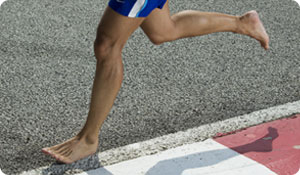
Could the pain in your feet be relieved if you ran in minimalist shoes, also known as barefoot running shoes, instead of traditional running shoes? It might—if you tread softly.
The recent wave of marketing behind these new lightweight shoes started with the book, Born to Run (Knopf 2009) by Christopher McDougal. While doing research to discover why his feet were in so much pain after running, he realized how new the invention running shoes actually are. Prior to the 1960s, everyone ran in sneakers, sandals, or barefoot. Sure, some barefoot runners injured their feet when they step on something or landed poorly, but McDougal suspected that some of today's runners are injured due to the extra weight, cushioning, and even protection that running shoes provides. Podiatrists point out that there has not been any reduction in running injuries from the invention of custom shoes.
Barefoot runners usually land on the ball or midpoint of the foot, not the heel. Many running experts and sports physiologists say that's the most natural "strike pattern." Runners, who train with traditional running shoes, however, tend to land on their heel, which isn't necessarily designed to take a pounding like other parts of the foot. This is called a "heel strike," which can cause damage to bones, ligaments, and tendons in the foot and ankle.
That's where barefoot running comes in. When runners hit the road without shoes on, they naturally land in a foot-protective way. Minimalist running shoes were designed to provide the foot with basic protection against sharp, slippery, or hard objects, but without adding extra cushioning, weight, or stabilizing mechanisms to correct pronation and arch problems.
Minimalist shoes might help some runners to correct poor running technique by forcing them to land on the least sensitive parts of their feet (ball and midpoint), but may also cause injury for others. Runners who are accustomed to a specific gait and strike pattern, such as hitting the ground heel first on a highly padded shoe, might have a tough time changing gears. In fact, abruptly changing their running technique can cause injury to vulnerable foot structures. Minimalist shoes' thin soles and top materials may not provide enough protection for people who run on pavement, city streets, or other rough surfaces.
So, what does the American Podiatric Medical Association say about the topic? Here's their policy statement:
Barefoot running is a possible alternative or training adjunct to running with shoes. While anecdotal evidence and testimonials proliferate on the Internet and in the media about the possible health benefits of barefoot running, research has not yet adequately shed light on the immediate and long-term effects of this practice.
Barefoot running has been touted as improving strength and balance, while promoting a more natural running style. However, risks of barefoot running include a lack of protection-which may lead to injuries such as puncture wounds-and increased stress on the lower extremities. Research is ongoing in regards to the risks and benefits of barefoot running.
The bottom line seems to be that running in minimalist shoes can be safe as long as the runner learns proper technique, doesn't run too far too soon in their re-training program, and he pays attention to how his feet feel. Podiatrists and running experts seem to agree: minimalist running shoes are worth a try.
Sources:
Born to Run, A Hidden Tribe, Super Athletes and The Greatest Race The World Has Never Seen
Christopher McDougal
Alfred A Knopf, New York, 2009
American Podiatric Medical Association
APMA Position Statement on Barefoot Running
http://www.apma.org/MainMenu/News/MediaRoom/PositionStatements/Barefoot-Running.aspx





